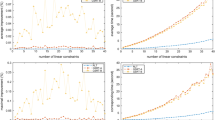Abstract
Quadratic Convex Reformulation (QCR) is a technique that has been proposed for binary and mixed integer quadratic programs. In this paper, we extend the QCR method to convex quadratic programs with linear complementarity constraints (QPCCs). Due to the complementarity relationship between the nonnegative variables \(y\) and \(w\), a term \(y^{T}Dw\) can be added to the QPCC objective function, where \(D\) is a nonnegative diagonal matrix chosen to maintain the convexity of the objective function and the global resolution of the QPCC. Following the QCR method, the products of linear equality constraints can also be used to perturb the QPCC objective function, with the goal that the new QP relaxation provides a tighter lower bound. By solving a semidefinite program, an equivalent QPCC can be obtained whose QP relaxation is as tight as possible. In addition, we extend the QCR to a general quadratically constrained quadratic program (QCQP), of which the QPCC is a special example. Computational tests on QPCCs are presented.
Similar content being viewed by others
References
Billionnet, A., Elloumi, E. Lambert, A.: Extending the QCR method to general mixed-integer programs. Math. Program. Ser. B 131, 381–401 (2012). doi:1.1007/s10107-010-038-7
Billionnet, A., Elloumi, E., Plateau, M.: Improving the performance of standard solvers for quadratic 0–1 programs by a tight convex reformulation: The QCR method. Dis. Appl. Math. 157, 1185–1197 (2009)
Bai, L., Mitchell, J.E. , Pang, J.S.: On convex quadratic programs with linear complementarity constraints. Comput. Opt. Appl. 54, 517–554 (2013). doi:10.1007/s10589-012-9497-4
Codato, G., Fischetti, M.: Combinatorial Benders’ cuts for mixed-integer linear programming. Oper. Res. 54, 738–766 (2006)
Fujie, T., Kojima, M.: Semidefinite programming relaxation for nonconvex quadratic programs. J. Global Opt. 10, 367–380 (1997)
Hu, J., Mitchell, J.E., Pang, J.S., Bennett, K.P., Kunapuli, G.: On the global resolution of linear programs with linear complementarity constraints. SIAM J. Opt. 19, 445–471 (2008)
Hu, J., Mitchell, J.E., Pang, J.S., Yu, B.: On linear programs with linear complementarity constraints. J. Global Opt. 53(1), 29–51 (2012)
Hu, J., Mitchell, J.E., Pang, J.S.: An LPCC approach to nonconvex quadratic programs. Math. Program. 133(1–2), 243–277 (2012)
Jiang, H., Ralph, D.: QPECgen, a MATLAB generator for mathematical programs with quadratic objectives and affine variational inequality constraints. Comput. Opt. Appl. 13, 25–59 (1999)
Galli, L., Letchford, A.N.: Extending the QCR method to mixed-integer quadratically constrained programs. Submitted to Math. Program. (2012)
Lemaréchal, C., Oustry, F.: Semidefinite relaxations and Lagrangian duality with application to combinatorial optimization. Technical Report RR-3710, INRIA Rhone-Alpes, ZIRST - 655 avenue de l’Europe F-38330 Montbonnot Saint-Martin, France, June (1999)
Lemaréchal, C., Oustry, F.: SDP relaxations in combinatorial optimization from a Lagrangian viewpoint. In: Hadjisavvas N, Pardalos P.M., (eds.) Advances in Convex Analysis and Global Optimization, chapter 6, vol. 54, pp. 119–134. Springer, Berlin (2001)
Luo, Z.Q., Pang, J.S., Ralph, D.: Mathematical Programs with Equilibrium Constraints. Cambridge University Press, New York (1996)
Mitchell, J.E., Pang, J.S., Yu, B.: Obtaining tighter relaxations of mathematical programs with complementarity constraints. In: Modeling and Optimization: Theory and Applications, Proceedings in mathematics and statistics. vol. 21, Springer, Berlin (2012)
Poljak, S., Rendl, F., Wolkowicz, H.: A recipe for semidefinite relaxation for (0,1)-quadratic programming. J. Global Opt. 7, 51–73 (1995)
Pang, J.S.: Three modeling paradigms in mathematical programming. Math. Program. Ser. B 125, 297–323 (2010)
Toh, K.C., Todd, M.J., Tutuncu, R.H.: SDPT3–a Matlab software package for semidefinite programming. Opt. Meth. Softw. 11, 545–581 (1999)
Acknowledgments
We are grateful to two anonymous referees for carefully reading the manuscript and for their helpful comments.
Author information
Authors and Affiliations
Corresponding author
Additional information
The work of Mitchell was supported by the National Science Foundation under grant DMS-0715446. The work of Mitchell and Bai was supported by the Air Force Office of Sponsored Research under grant FA9550-08-1-0081 and FA9550-11-1-0260. The work of Pang was supported by the USA. National Science Foundation grant CMMI 0969600 and by the Air Force Office of Sponsored Research under grants FA9550-08-1-0061 and FA9550-11-1-0151.
Rights and permissions
About this article
Cite this article
Bai, L., Mitchell, J.E. & Pang, JS. Using quadratic convex reformulation to tighten the convex relaxation of a quadratic program with complementarity constraints. Optim Lett 8, 811–822 (2014). https://doi.org/10.1007/s11590-013-0647-0
Received:
Accepted:
Published:
Issue Date:
DOI: https://doi.org/10.1007/s11590-013-0647-0




